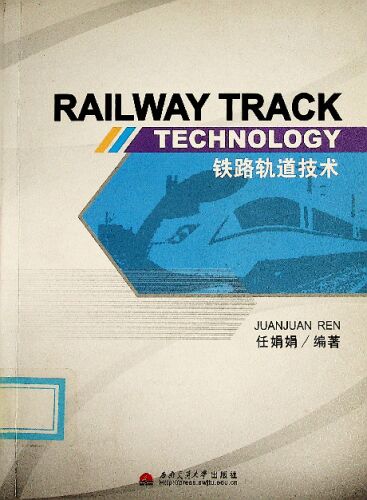书名:Railway track technology
前言
Beginning from the construction of Qinhuangdao-Shenyang Passenger Dedicated Line in 1999, the Chinese high speed railway develops rapidly and the first Chinese high speed railway (Beijing-Tianjin Passenger Dedicated Line) began its service in 2008. By the end of 2013, the total length of high speed railway line in China had become the longest in the world with more than 11 000 km in operating and another 14 160 km in building.
Started several decades later than that in developed countries, the high speed railway in China develops much faster. During the last 20 years, the Chinese high speed railway has made a series of significant achievements in the aspects of civil engineering, rolling stock, communication, signal, operation management and security monitoring, etc, which leads to the formation of the high speed railway technological system with Chinese characteristics and China's entry of countries with the advanced technologies. From the "late-corner" to the "pursuer" to the "leader", the Chinese high speed railway is moving towards to the internationalization.
As one of the main Chinese high speed railway technology equipments, the track structure has achieved a lot of breakthroughs in design principles, design methods, monitoring and maintenance, etc. In order to adapt to the internationalization of high speed railway and cultivate internationalized talents of high speed railway, I have written this book based on the teaching requirements of railway track technology. This book presents the main components, basic principles, fundamental knowledge and skills of railway track, by which the mature achievements in the world are introduced.
This book is divided into 8 chapters. The first chapter introduces the track structure, including the type and requirements of the main components. Chapter 2 presents the track geometry. Chapter 3 is dealing with the dynamic response of the track and its component parts (especially their stresses and deformation) under the action of rolling stocks with different operational conditions. Chapter 4 describes the wheel-rail interface, including the wheel-rail guidance, lateral movement of a wheelset on straight track, equivalent conicity, worn wheel profiles, wheel-rail contact stresses and train resistances. Chapter 5 focuses on the design and constitute of different slab tracks. Chapter 6 introduces the switches from its function, structure and dimensions. Chapter 7 presents the Continuously Welded Rail track (CWR track), introducing the principles, stability and design of CWR track. In this part, the CWR track on bridges is extensively discussed. Chapter 8 outlines the track maintenance and repair, including the inspection of track geometry, fundamental principles, regular maintenance, arrangements of curtailed rails on curved tracks, string lining of curves and capital repair of tracks.
Although many contents presented in this book were developed by myself through years of research, teaching, and engineering practice, much information was obtained from the published literature, especially Track Compendium: Formation, Permanent Way, Maintenance, Economics by Dr. Bernhard Lichtberger, Railroad Track by T.H.TUNG and Modern Railway Track (Second Edition) by Coenraad Esveld, my deepest gratitude goes first and foremost to them.
查看更多
目录
1 The Track Structure / 1
1.1 General Information / 1
1.2 Rail/ 2
1.3 Sleepers /ties/ 7
1.4 Joining of Rails/ 18
1.5 Rail Fastenings / 24
1.6 Ballast and Ballast bed/ 34
2 Track Geometry / 43
2.1 General Information / 43
2.2 Running Gear of Rolling Stocks / 44
2.3 Track Geometry Elements / 48
2.4 Gauge Widening on Curved Tracks / 56
2.5 Super elevation on Curved Tracks / 63
2.6 Easement Curve or Transition Spiral 71
3 Mechanical Analysis of Track / 84
3.1 Introduction / 84
3.2 Force Acting on the Track / 86
3.3 Static Calculations of Track Under Virtual Loads一theory of Beams on Continuous Elastic Foundations / 90
4 Wheel-rail Interface / 103
4.1 Wheel-rail guidance / 103
4.2 Wheelset and Track Dimensions / 103
4.3 Coni city / 105
4.4 Lateral Movement of a Wheelset on Straight Track / 105
4.5 Equivalent Coni city / 109
4.6 Worn Wheel Profiles / 110
4.7 Wheel-rail Contact Stresses / 112
4.8 Train Resistances/ 119
5 The Slab Track / 123
5.1 Requirements of Slab Track / 123
5.2 Inserted Design Types on Support Points with Sleeper / 136
5.3 Laid-on Design / 132
5.4 Monolithic Designs on Supporting Points without Sleeper / 134
5.5 Pre-fabricated Designs on Supporting Points without Sleeper / 135
5.6 Sleepers or Blocks Embedded in Concrete / 139
5.7 Structures with Asphalt-concrete Road bed/ 140
5.8 The Rail Fastening / 141
5.9 The Calculation Method / 146
6 The Switches / 150
6.1 Summary / 150
6.2 The Standard Turnout / 151
6.3 Geometry of the Turnout / 158
6.4 Types of Turnouts and Crossings / 159
6.5 Elements of Switches / 162
6.6 Speed Through Tum out and Means of Increasing it/ 173
6.7 Laying and Maintenance of Tum out/ 185
7 Continuously Welded RailTrack(CWR Track) / 190
7.1 General Information / 190
7.2 Fundamental Principles / 194
7.3 Stability of CWR Track / 216
7.4 Design of CWR Tracks / 232
7.5 CWR track on Bridges / 237
8 Track Maintenance and Repair / 255
8.1 Inspection of Track Geometry / 255
8.2 Fundamental Principles for Maintenance Work / 258
8.3 Regular Maintenance of Track / 261
8.4 Arrangements of Curtailed Rails on Curved Tracks / 266
8.5 String Lining of Curves / 269
8.6 Capital Repair of Tracks / 279
References / 292
查看PDF
查看更多
馆藏单位
中科院文献情报中心



